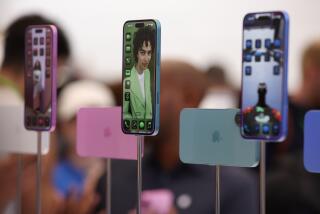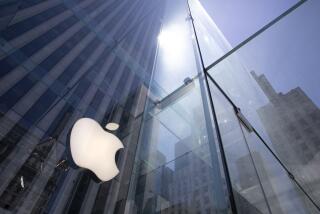Shaky debut for CEO, new iPhone
CUPERTINO, CALIF., AND SAN FRANCISCO — Apple began its new era with a creation unlike anything it had produced in years: disappointment.
Instead of a major new product, the electronics giant unveiled an updated version of the iPhone 4 that it released 16 months ago. Even the name, iPhone 4S, resembled the old phone.
Most observers had expected that in the company’s first unveiling without co-founder Steve Jobs, Apple would try to show it was still capable of wowing crowds with stunning new devices.
Immediately after the company showed off its updated smartphone, shares of Apple plunged nearly 5%. Though they largely recovered by the time the market closed, investors agreed that Tuesday’s unveiling was not Apple’s best performance.
“It’s kind of unfortunate timing that the first post-Jobs product is not the most exciting in the world,” said Alex Spektor, a wireless analyst at Strategy Analytics, who called the new phone an “incremental” improvement over the iPhone 4. By choosing not to call the device the iPhone 5, he said, “Apple is admitting that it’s basically the same phone but with some souped-up specifications.”
Unlike Jobs, who tended to stay on the stage for most of a product unveiling, Apple’s new chief executive, Tim Cook, spoke for only a small part of the nearly two-hour presentation. The Alabama native spoke about Apple’s music, retail and computer business -- pausing to joke about all the buzz over the new iPhone -- but let his lieutenants introduce the new device and many of its features.
Without Jobs and his trademark ability to build excitement around a new product, some observers felt the presentation was missing some of Apple’s pizazz. “This was not a home run for Tim Cook,” said Colin Gillis, an analyst with BGC Partners. “It was adequate. All he can do is be his own person -- he’ll get more chances.”
The company also seemed to disappoint consumers who were expecting Apple to announce that the iPhone would be available to customers at wireless providers besides AT&T; and Verizon Wireless.
After the event, Apple’s website listed Sprint among the carriers that would sell the phones in the U.S. The carrier is listed on a Web page comparing iPhone models.
Apple did not return requests for comment, but a Sprint spokeswoman confirmed in an email that the carrier would join AT&T; and Verizon in selling the new phone along with the $99 iPhone 4. The iPhone 3GS, however, will be available only from AT&T.;
Still, some analysts felt that the launch -- if not sensational -- was a smart business move by Apple, which is locked in an intense battle with rival smartphone makers, chiefly companies like Samsung Electronics Co. and HTC that make Google Inc.-powered Android phones, some at low prices.
By offering its own series of lower-cost phones, Apple is aiming at the swelling segment of smartphone consumers in fast-growing markets in Asia and South America, where many first-time buyers can’t afford the higher-end phones.
“They are satisfying the broadening demand of the market,” said Charles Golvin, an analyst with Forrester Research. “It’s a good strategy on Apple’s part.”
The iPhone 4S will go on sale late this month starting at $199 with a two-year contract.
The device has a faster computer processor and a higher-quality internal camera, but is largely a series of smaller upgrades to the iPhone 4, which has become the company’s bestselling product. Apple also lowered the price on the iPhone 4, and will give the earlier iPhone 3GS to wireless customers free of charge.
Perhaps the closest thing the company came to a “wow”-inducing new feature was the introduction of a voice-activated digital “personal assistant.” Called Siri, the feature takes voice commands from the user -- “Help me find a good Greek restaurant nearby,” “Do I need a raincoat today?” or “Schedule me for a noon lunch with Jane” -- and dutifully performs the task and reports back in a computerized female voice.
“It’s a harbinger of very significant change in terms of how people interact with and control their devices,” Golvin said.
One of the day’s minor flourishes was Apple’s announcement of its new Cards application, which lets iPhone users put photos they have taken into fancy printed greeting cards. The sender can add a personal message and Apple will print and mail the card, even alerting the sender by text message when it arrives.
The news of Apple’s easy-to-use approach to greeting cards instantly sent the stocks of card companies spinning -- shares of American Greetings Corp. dropped more than 6%, and the Web-based card maker Shutterfly lost nearly 11% before staging a late comeback.
But some observers saw a bright side for another troubled company.
“I think Apple is trying to bail out the U.S. Postal Service,” joked Twitter user Ariel Waldman.
--
jessica.guynn@latimes.com
Times staff writer Nathan Olivarez-Giles contributed to this report.





